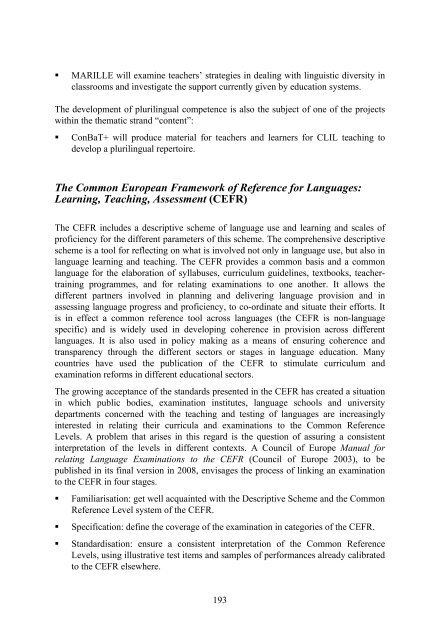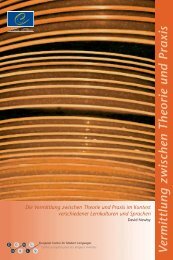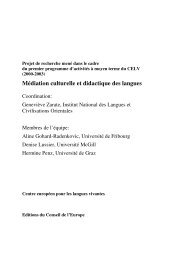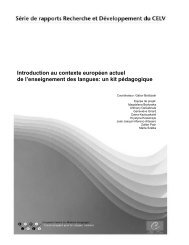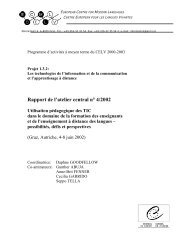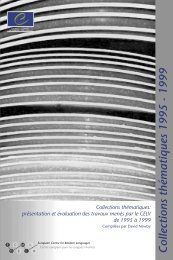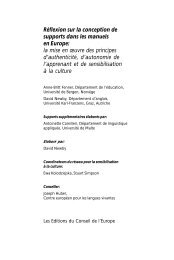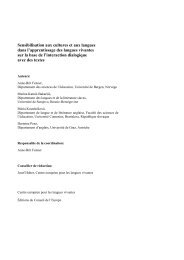cohesion - European Centre for Modern Languages
cohesion - European Centre for Modern Languages
cohesion - European Centre for Modern Languages
Create successful ePaper yourself
Turn your PDF publications into a flip-book with our unique Google optimized e-Paper software.
MARILLE will examine teachers’ strategies in dealing with linguistic diversity in<br />
classrooms and investigate the support currently given by education systems.<br />
The development of plurilingual competence is also the subject of one of the projects<br />
within the thematic strand “content”:<br />
ConBaT+ will produce material <strong>for</strong> teachers and learners <strong>for</strong> CLIL teaching to<br />
develop a plurilingual repertoire.<br />
The Common <strong>European</strong> Framework of Reference <strong>for</strong> <strong>Languages</strong>:<br />
Learning, Teaching, Assessment (CEFR)<br />
The CEFR includes a descriptive scheme of language use and learning and scales of<br />
proficiency <strong>for</strong> the different parameters of this scheme. The comprehensive descriptive<br />
scheme is a tool <strong>for</strong> reflecting on what is involved not only in language use, but also in<br />
language learning and teaching. The CEFR provides a common basis and a common<br />
language <strong>for</strong> the elaboration of syllabuses, curriculum guidelines, textbooks, teachertraining<br />
programmes, and <strong>for</strong> relating examinations to one another. It allows the<br />
different partners involved in planning and delivering language provision and in<br />
assessing language progress and proficiency, to co-ordinate and situate their ef<strong>for</strong>ts. It<br />
is in effect a common reference tool across languages (the CEFR is non-language<br />
specific) and is widely used in developing coherence in provision across different<br />
languages. It is also used in policy making as a means of ensuring coherence and<br />
transparency through the different sectors or stages in language education. Many<br />
countries have used the publication of the CEFR to stimulate curriculum and<br />
examination re<strong>for</strong>ms in different educational sectors.<br />
The growing acceptance of the standards presented in the CEFR has created a situation<br />
in which public bodies, examination institutes, language schools and university<br />
departments concerned with the teaching and testing of languages are increasingly<br />
interested in relating their curricula and examinations to the Common Reference<br />
Levels. A problem that arises in this regard is the question of assuring a consistent<br />
interpretation of the levels in different contexts. A Council of Europe Manual <strong>for</strong><br />
relating Language Examinations to the CEFR (Council of Europe 2003), to be<br />
published in its final version in 2008, envisages the process of linking an examination<br />
to the CEFR in four stages.<br />
Familiarisation: get well acquainted with the Descriptive Scheme and the Common<br />
Reference Level system of the CEFR.<br />
Specification: define the coverage of the examination in categories of the CEFR.<br />
Standardisation: ensure a consistent interpretation of the Common Reference<br />
Levels, using illustrative test items and samples of per<strong>for</strong>mances already calibrated<br />
to the CEFR elsewhere.<br />
193


